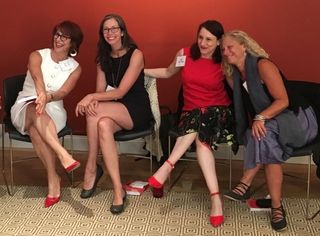Introversion
Stretch Opportunity for Introverts: Applied Improvisation
Improve your workplace with the tools of improvised theater.
Posted August 6, 2018

Some dangers aren’t really dangerous–not to life and limb, anyhow. Take improvisation, which you actually do every day. Your boss is late to a crucial meeting that you know nothing about and asks you to facilitate. Your computer freezes while you’re under deadline. A hiring manager for your dream job asks you an outrageous question on an interview.
How can we make real-world improvising less treacherous, and even fun, for introverts in the workplace? Master improviser Carl Kissin shared some tips during our recent discussion. Since then, I spoke with Caitlin McClure about how you can help your whole team benefit from the tools of improvised theater. McClure has been designing and facilitating leadership development programs worldwide using applied improvisation as a key methodology. Her new book, Applied Improvisation: Leading, Collaborating, and Creating Beyond the Theatre reveals a wealth of stories and easy-to-use tools that you can immediately add to your own toolbox.

NA: What is applied improvisation?
CM: It is the practice of using the techniques and theories of improvised theater and applying them to something other than theatrical performance.
NA: Would you give an example?
CM: Cathy Salit runs an organization based in NYC called Performance of a Lifetime (POAL). For more than 20 years, POAL has been opening up the toolbox of improv to help leaders and independent contributors in the workplace courageously take risks, adapt to the unexpected with more agility, and handle difficult conversations with ease. She wrote a case study for my book about her work helping oncology nurses at Johns Hopkins develop more resiliency. POAL uses the same improv games that performers use, but adapts them for the workplace.
NA: How valuable! Yet, the word “games,” like “improv,” evokes terror in many an introvert.
CM: You’ve hit on one of the biggest barriers to this work: the terminology. This is one of the reasons my co-editor, Theresa Robbins Dudeck, and I were so driven to create this book. People hear “improv” and they think comedy. They hear “games” and they think unprofessional and childish. I have done regular improv and applied improv with introverts, and nobody has yet run out of the room feeling terrorized! In fact, many of the best facilitators of this work are introverts .
NA: Right. While introverts are often not drawn to taking improv classes because they like to think before sharing their thoughts, they can learn to build their improv muscles. That often starts with the simple two words, “yes, and.” Caitlin, how about if we demonstrate that?
CM: Yes! How about if you start us off?
NA: Caitlin, why don’t we co-host an improv event for our colleagues?
CM: Yes, and we could serve them tea and cookies.
NA: Yes, and we could use my new tea-and-cookie set.
CM: No, I don’t like that idea.
NA: Ouch, Caitlin. I have to go now. I just remembered that I have to pay a bill.
CM: Exactly! It’s more fun to pay bills than to have me shoot down your ideas. While there are plenty of times to be critical and say no to ideas, most people under-use other conversational choices like yes, and. That means they are missing out on some great opportunities to build on other people’s ideas. One of the things we practice in improv is building up the yes, and muscle so that it is as strong as the no muscle, which we hear in the business world all the time.
NA: What are other options for answering an open-ended question, such as the one I started with? I’ll ask again: Why don’t we co-host an improv event for our colleagues?
CM: No, we should host an event only for our friends.
NA: Thud. Thank you. How about a more positive response? One last time. Why don’t we co-host an improv event for our colleagues?
CM: Yes, but…I’m really busy right now.
NA: So even a “yes, but” response is a form of a no. Correct?
CM: That’s correct. You can easily tell by observing whether the forward momentum of a conversation continues or feels blocked.

NA: How do you use a game like this in the workplace?
CM: We might ask people to pair up and plan an imaginary party just like you and I did. In each round, they would practice different responses (yes, and; yes, but; no, we should…). The key to applied improvisation, as opposed to stage improvisation, is providing participants opportunities to reflect on an experience. So, after playing the different rounds of the game, we might ask them to describe how each round was different from the next. Then we ask them to connect the dots between the game and their work lives.
For instance, we may ask participants to think about a specific time in their workplace when they’ve seen someone shoot down their ideas by saying, “yes, but…”? What was the result of that interaction? What would be different if their teams were to say, “yes, and” more often?
Planning a "yes, and" party is a standard improv game that improvisers use to help them perform onstage. But this same game works beautifully to help people strengthen their yes, and muscle for use offstage, as well.
NA: We’ve demonstrated why "yes, and" is the well-deserved darling of improv. What are a few other basic tenets?
CM: Appendix A in my book describes some of the most commonly held tenets, but this is a living tradition, so every improv school has its own way to describe them. I wrote a chapter about my time as a senior management consultant at Tiffany & Co., where we reworded the term “yes, and” to make it sound more businesslike. The tenets we used at Tiffany were: commit, make your partner look good, build with what you are given (yes, and), treat mistakes as gifts, be curious, and be obvious.
NA: They’re all important. Yet, one of my favorites has always been to make your partner look good. Applying that in the business world, where so many people elbow their way upward, it’s refreshing to remember that principle.
CM: That reminds me of Project Aristotle at Google, in which researchers determined that high performing teams shared two characteristics: equal turn-taking and that all team members had average or higher social sensitivity. In other words, team members make their partners look good. If you and I are collaborating on something and you do your best to make me look good and vice versa, our final project will look good. And we’re probably going to enjoy the process along the way.
NA: Yes, and sometimes it’s easier to make you than me look good. Tooting someone else’s horn is often easier than tooting your own horn. Another one of my favorite improv tenets that you cover is “treat mistakes as gifts.” What do you mean by that?
CM: Treating mistakes as gifts is something that business-world clients challenge the most. Some real-world mistakes can have serious consequences, so encouraging mistakes can mean courting danger.
NA: Yes, it’s a delicate dance. On the one hand, you often hear that you have to make mistakes to learn. But how many managers really want their staff to make mistakes?
CM: That’s a great metaphor, a delicate dance. Sometimes stretching and learning from a mistake is the right choice. Other times, there is zero tolerance for error. So, I encourage leaders to be intentional with how they use their time and energy with their teams. If they create teams that are exclusively risk averse, they will have limited success.
NA: Another aspect of making mistakes are the consequences for not only the organization, but the individual employee. How will their boss critique them? Will it be in private?
CM: Each leader creates their own organizational climate for their teams. Some leaders create climates in which mistakes are seen as learning opportunities. These leaders are transparent with their own successes and mistakes and they respectfully share feedback about their direct reports’ successes and failures, providing opportunities to learn.
Unfortunately, other leaders create climates that do not encourage risk, and do not treat mistakes as gifts. We must learn to work within our leader’s expectations. If my leader sees a mistake as a learning opportunity, I will share my slip ups with them, and together we can find good solutions. If my leader sees every slip up as unacceptable, then I will probably hide my mistakes and hope they don’t find out. The latter option is not healthy or sustainable for me, my boss, or my organization.
NA: Indeed. Leaders who encourage risk and treat mistakes as gifts create a safe environment for their team members. Along those lines, another tenet that I adore is “be curious.” In so many workplaces, discussions get heated and employees get angry and defensive. Would you give an example of how to counter that?
CM: Be curious is one of my favorites, too, and is perfect for keeping disagreements from becoming full-blown conflicts. Healthy organizations know that disagreements are normal

and actually result in stronger decisions and more innovation. Be curious invites me to ask you about your point of view, especially when I disagree with it!
NA: So, Caitlin, I think we should sell ACME’s headquarters building for a dollar.
CM: My initial response is to say you’re out of your mind. A dollar?! But to follow the tenet to be curious, I acknowledge my initial response of judging what you said and then try to be curious. So I might think, well, Nancy’s smart and she’s good with a budget, so she must have a good idea why she suggests we do this. Let me find out more before I tell her she’s out of her mind. I might say, Nancy, tell me more. What’s your rationale?
NA: Great response, Caitlin. You’re giving the other party, me, an opportunity to explain my idea, rather than putting it down or dismissing it. And putting our heads together can lead to a much better idea.
CM: Much like creating this conversation together is much better than if I had tried to do it myself!

NA: Right. Before we wrap up this discussion, tell me what inspired you to compile this book.
CM: When I first started practicing applied improvisation more than 20 years ago, people would look at me quizzically: Improv? In business? Now, I have colleagues in South Africa, Turkey, Hong Kong, Finland, and Holland, all using the tools and techniques of improv to help kids on the autism spectrum explore empathy, to help college campuses facilitate difficult conversations about diversity, and to help small groups prepare for disasters—all chapters in my book, by the way. We collected these stories so that readers would see all the possibilities of applied improvisation, rather than think only of comedy.
NA: What’s different about your book?
CM: We give away some of our best secrets. Our goal is to encourage everyone to explore the practical, effective world of applied improv. So each of chapter includes a case study as well as simple instructions for how to lead some of the same games used in it. Readers can mix and match any of the 30 games in the book and start doing applied improvisation in their own organizations. Another differentiator is that we illustrate the depth and breadth of this field. Twelve practitioners from all over the world use the same improv tools and theories and apply them to different situations to help people in almost any endeavor.
NA: Is there anything else you’d like to add?
CM: It has been so exciting to see how this field has grown since I started. Performance improv often appeals to a very extroverted group. By taking improv offstage, everyone can participate and benefit from the power of these improv tenets–introverts and extroverts alike.
NA: Thank you for sharing your passion for applied improv and describing how introverts, in particular, can benefit from it.
Copyright © 2018 Nancy Ancowitz




